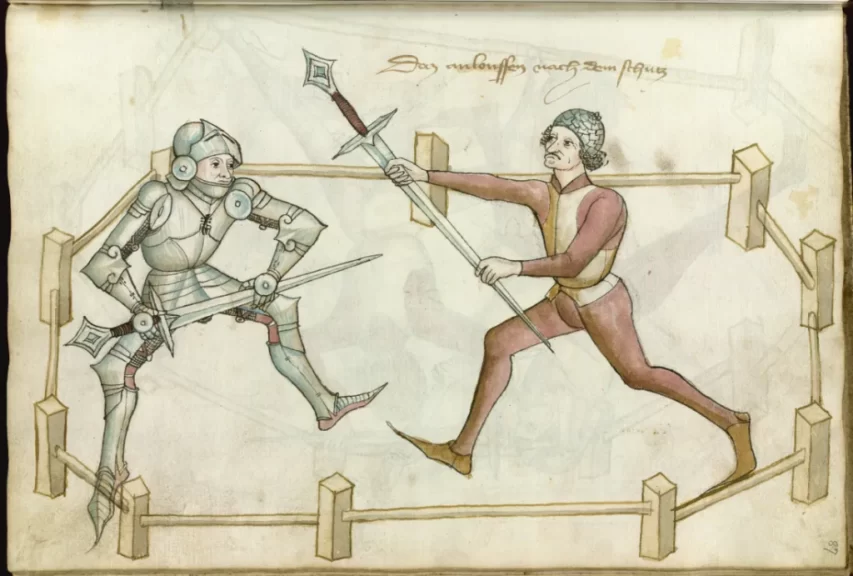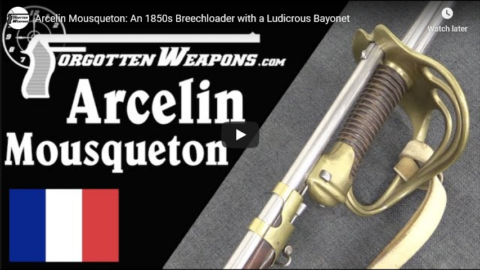Jill Bearup
Published Jun 3, 2024They’re MEN. They’re men in TIGHTS (tight tights!) Please enjoy the extended edition of this video with many random digressions that will mostly be cut for the public version
00:00 Robin Hood: Men in Tights
00:50 The Plot, It Goeth Thusly
03:03 Prince of Thieves/Men in Tights/Maid Marian and Her Merry Men
04:50 What kind of fight do you like?
06:19 Setup for the ending fight
07:03 The Prince of Thieves fight
07:38 The Adventures of Robin Hood fight
07:53 FIGHT!
08:53 My favourite thing (compare and contrast)
10:03 The first phrase
10:39 The second phrase
11:24 The third phrase
11:43 The fourth phrase
12:29 The fifth phrase
12:40 and FIN
13:13 I love it, I really do
14:17 Book chat
15:52 Men hitting each other with sticks
17:40 Matching vibes
18:46 Just Stab Me Now audiobook update
(more…)
September 11, 2024
 Parry!
Parry!  Parry!
Parry!  Thrust!
Thrust!  Thrust! GOOD!
Thrust! GOOD!
 Parry!
Parry!  Parry!
Parry!  Thrust!
Thrust!  Thrust! GOOD!
Thrust! GOOD! August 28, 2024
Then I’ll Take Her When You’re  Dead
Dead !
!
Jill Bearup
Published May 13, 2024Ah, Captain Blood. Swords, sand, and piratical shenanigans. Let’s do this.
The Fight Master Vol 1 Issue 1: https://mds.marshall.edu/fight/1/
Buy my book: books2read.com/juststabmenow (or try your local Amazon/bookstore)
 Dead
Dead !
! August 12, 2024
Robin Hood, But Make it  ICONIC
ICONIC
Jill Bearup
Published Apr 29, 2024The Adventures of Robin Hood (1938) is a classic, and I am hopefully unlikely to get in copyright trouble if I use huge chunks of it. So prepare for an exhaustive (or possibly exhausting) fight breakdown, and a few minor comments about Errol Flynn and parrying.
(more…)
 ICONIC
ICONIC
July 2, 2024
They Don’t Make Them Like  This
This Any More …
Any More …
Jill Bearup
Published Mar 18, 2024Ah, The Mark of Zorro. You will be endlessly told as a stage combatant that this is one to watch. There’s a reason for that, friends.
This video is sponsored by ME: https://books2read.com/juststabmenow
 This
This Any More …
Any More … February 14, 2024
Soviet World War Two Swords? The M1927 Shashka
Cossack forces have long been a key cavalry element of the Russian military, and this did not change during the Soviet era. The Cossacks had their own rather distinctive style of sword, the shashka, and the Red Army maintained the tradition of issuing them to Cossack cavalry troopers. In 1927, a new pattern was adopted, and it was produced and issued from 1928 until 1946. The shashka has a slightly curved, single-edged blade and no handguard. The model 1927 military type was initially made with a rather decorative pommel, but this was simplified to just a plain 5-pointed star as German advances into Russia really stressed Soviet industrial production. However, production and issue of the shashka continued uninterrupted throughout the war.
Originally there were separate trooper and officer versions of the model 1927, with the trooper version including the ability to stow the trooper’s Mosin-Nagant rifle bayonet on the side of the shaskha scabbard. As cavalry, the Cossacks were not expected to carry their rifles with bayonets fixed, and this served in lieu of a bayonet sheath. By 1944 this feature was omitted, as the M91/30 was replaced by the M38 and M44 carbines and submachine guns, which did not use bayonets.
The decorations returned to the M1927 shashka in 1945, with a series made for the Victory Day parade celebrating the defeat of Germany. Today’s example is one of these, and in beautiful condition.
January 3, 2024
December 28, 2022
What we still don’t know about historical European swordfighting
I was for many years a member of the SCA partly for the attraction of the historical period and partly for the swordfighting. The Society developed a (mostly) safe simulation of (some) medieval combat styles and later introduced (some) renaissance rapier combat as well (initially borrowing equipment standards from modern sport fencing). Around the time the SCA began to consider expanding from high medieval sword-and-shield styles, separate organizations in Europe and the United States sprang up to be more consciously historical in how they recreated historical blade combat, these groups are often collectively referred to as Historical European Martial Arts (HEMA) or Western Martial Arts (WMA). The foundation documents for HEMA and other historical combat enthusiasts are the various surviving manuals of swordmasters and fencing school owners which cover a kaleidoscope of weapons, techniques, advice, and how-to illustrations … some of which appear to be physically impossible for ordinary human beings:
The ultimate experts in medieval sword fighting were the “fight masters” – elite athletes who trained their disciples in the subtle arts of close combat. The most highly renowned were almost as famous as the knights they trained, and many of the techniques they used were ancient, dating back hundreds of years in a continuous tradition.
Little is known about these rare talents, but the scraps of information that have survived are full of intrigue. Hans Talhoffer, a German fencing master with curly hair, impressive sideburns and a penchant for tight body suits, had a particularly chequered past. In 1434, he was accused of murdering a man and admitted abducting him in the Austrian city of Salzburg.
Fight masters worked with a grisly assortment of deadly weapons. The majority of training was dedicated to fencing with the longsword, or the sword and buckler (a style of combat involving holding a sword in one hand, and a small shield in the other). However, they also taught how to wield daggers, poleaxes, shields, and even how to fight with nothing at all, or just a bag of rocks (more on this later).
It’s thought that some fight masters were organised into brotherhoods, such as the Fellowship of Liechtenauer – a society of around 18 men who trained under the shadowy grandmaster Johannes Lichtenauer in the 15th Century. Though details about the almost-legendary figure himself have remained elusive, it’s thought he led an itinerant life, travelling across borders to train a handful of select proteges and learn new fencing secrets.
Other fight masters stayed closer to home – hired by dukes, archbishops and other assorted nobles to train themselves and their guards. A number even set up their own “fight schools”, where they gathered less wealthy students for regular weekly sessions.
[…]
For all their beauty, the hand-drawn works could also be decidedly bloodthirsty. In Talhoffer’s 1467 manual, neat sequences of moves that look almost like dancing end abruptly with swords through eye-sockets, violent impalings, and casual instructions to beat the opponent to death. Some signature techniques even have names – chilling titles like the “wrath-hew”, “crumpler”, “twain hangings”, “skuller” and “four openings”.
Despite passing through countless generations of owners, and – in some cases – centuries of graffiti, burns, theft, and mysterious periods of vanishment from the historical record, a surprising number survive today. This includes at least 80 codexes from German-speaking regions alone.
Impossible moves and missing clues
But there’s a problem. Many of the techniques in combat manuals, also known as “fechtbücher“, are convoluted, vague, and cryptic. Despite the large corpus of remaining books, they often offer surprisingly little insight into what the fight master is trying to convey.
“It’s famously difficult to take these static unmoving woodcut images, and determine the dynamic action of combat,” says Scott Nokes, “This has been a topic of debate, research and experimentation for generations.”
On some occasions these manuals seem to depict contortions of the body that are physically impossible, while those that attempt to convey moves in three dimensions sometimes give combatants extra arms and legs that were added in by accident. Others contain instructions that are frustratingly opaque – sometimes depicting actions that don’t seem to work, or building upon enigmatic moves that have long-since been lost.
Oddly, the text is often written as poetry, rather than prose – and a few authors even made it hard to interpret their works on purpose.
Lichtenauer recorded his instructions in obscure verses which remain almost incomprehensible today – one expert has gone so far as to call them “gibberish”. According to a contemporary fight master he trained, the grandmaster wrote in “secret words” to prevent them from being intelligible to anyone who didn’t value his art highly enough.
Even when it is possible to decipher what a combat manual is describing or demonstrating, some experts suspect that crucial contextual information is always missing.
December 1, 2022
QotD: Movie swordfighting
I was reminded, earlier today, that one of the interesting side effects of knowing something about hand-to-hand and contact-weapons-based martial arts makes a big difference in how you see movies.
Most people don’t have that knowledge. So today I’m going to write about the quality of sword choreography in movies, and how that has changed over time, from the point of view of someone who is an experienced multi-style martial artist in both sword and empty hand. I think this illuminates a larger story about the place of martial arts in popular Western culture.
The first thing to know is this: with only rare exceptions, any Western swordfighting you see in older movies is going to be seriously anachronistic. It’s almost all derived from French high-line fencing, which is also the basis for Olympic sport fencing. French high-line is a very late style, not actually fully developed until early 1800s, that is adapted for very light thrusting weapons. These are not at all typical of the swords in use over most of recorded history.
In particular, the real-life inspirations for the Three Musketeers, in the 1620s, didn’t fight anything like their movie versions. They used rapiers – thrusting swords – all right, but their weapons were quite a bit longer and heavier than a 19th-century smallsword. Correspondingly, the tempo of a fight had to be slower, with more pauses as the fighters watched for an opening (a weakness in stance or balance, or a momentary loss of concentration). Normal guard position was lower and covered more of center line, not the point-it-straight-at-you of high line. You find all this out pretty quickly if you actually train with these weapons.
The thing is, real Three Musketeers fencing is less flashy and dramatic-looking than French high-line. So for decades there was never any real incentive for moviemakers to do the authentic thing. Even if there had been, audiences conditioned by those decades of of high-line would have thought it looked wrong!
Eric S. Raymond, “A martial artist looks at swordfighting in the movies”, Armed and Dangerous, 2019-01-13.
November 24, 2022
Can I make an AUTHENTIC Katana from wood?
Rex Krueger
Published 23 Nov 2022Historical weapon, beautiful construction & a great holiday gift, Katanas have it all!
Patrons get all plans early: http://www.patreon.com/rexkrueger
Get the FREE templates!: https://www.rexkrueger.com/store (scroll down to bottom of page).
(more…)
August 23, 2022
Reject Modernity; Embrace Tradition: The Type 95 Shin Gunto
Forgotten Weapons
Published 28 Apr 2022When Japan opened up to the outside world and began to industrialize in the late 1800s, it instituted major military reforms. In place of the samurai tradition, the new Japanese Imperial armed forces emulated the major European powers — France, Germany, and the United Kingdom. One element of this was the replacement of traditional swords with European styles for officers and civil officials.
These swords remained until the mid 1930s, when a wave of nationalist sentiment ran through Japanese society. In 1934, a new model of officer’s sword was adopted, which took the style of a traditional katana. A similar (but less fancy) model was adopted in 1935 for non-commissioned officers. These were the Type 34 and Type 35 respectively, and they are some of the most common Japanese swords in the United States, as many were brought back as souvenirs by American soldiers.
Today we are looking at my Type 95, using Headstamp’s upcoming book Swords of the Emperor as a guide.
(more…)
August 4, 2022
QotD: Errol Flynn versus Basil Rathbone in the 1938 Adventures of Robin Hood
A lot of swordfighting in medieval-period movies is even less appropriate if you know what the affordances of period weapons were. The classic Errol Flynn vs. Basil Rathbone duel scene from the 1938 Adventures of Robin Hood, for example. They’re using light versions of medieval swords that are reasonably period for the late 1100s, but the footwork and stances and tempo are all French high line, albeit disguised with a bunch of stagey slashing moves. And Rathbone gets finished off with an epée (smallsword) thrust executed in perfect form.
It was perfect form because back in those days acting schools taught their students how to fence. It was considered good for strength, grace, and deportment; besides, one might need it for the odd Shakespeare production. French high-line because in the U.S. and Europe that was what there were instructors for; today’s Western sword revival was still most of a century in the future.
This scene exemplifies why I find the ubiquitousness of French high-line so annoying. It’s because that form, adapted for light thrusting weapons, produces a movement language that doesn’t fit heavier weapons designed to slash and chop as well as thrust. If you’re looking with a swordsman’s eye you can see this in that Robin Hood fight. Yes, the choreographer can paste in big sweeping cuts, and they did, but they look too much like exactly what they are – theatrical flourishes disconnected from the part that is actually fighting technique. When Flynn finishes with his genuine fencer’s lunge (not a period move) he looks both competent and relieved, as though he’s glad to be done with the flummery that preceded it.
At least Flynn and Rathbone had some idea what they were doing. After their time teaching actors to fence went out of fashion and the quality of cinematic sword choreography nosedived. The fights during the brief vogue for sword-and-sandal movies, 1958 to 1965 or so, were particularly awful. Not quite as bad, but all too representative, was the 1973 Three Musketeers: The Queen’s Diamonds, a gigantic snoozefest populated with slapdash, perfunctory swordfights that were on the whole so devoid of interest and authenticity that even liberal display of Raquel Welch’s figure could not salvage the mess. When matters began to improve again in the 1980s the impetus came from Asian martial-arts movies.
Eric S. Raymond, “A martial artist looks at swordfighting in the movies”, Armed and Dangerous, 2019-01-13.
April 10, 2022
July 31, 2021
Can You Swordfight in a Wedding Dress?
Jill Bearup
Published 17 May 2021If you’re anticipating sword-wielding baddies at your wedding, you may well need these handy tips on the best way to sword fight in your wedding dress, or other big-skirted ballgown.
Live your best dark royaltycore life, who am I to tell you not to.
Contains very little actual fighting, because … who am I even going to fight?
Still, maybe people will be available for more fight shenanigans soon.
Music from epidemicsound.com
“Oceanic Adventure” – Bonnie Grace
“Rendezvous in D Minor” – Trevor Kowalski
“Faith Arise” – Edgar Hopp
November 1, 2020
Arcelin Mousqueton: An 1850s Breechloader with a Ludicrous Bayonet
Forgotten Weapons
Published 26 Jun 2020http://www.patreon.com/ForgottenWeapons
https://www.floatplane.com/channel/Fo…
Cool Forgotten Weapons merch! http://shop.bbtv.com/collections/forg…
The Arcelin system was a capping breechloader provisionally adopted by the French military in 1854. It was a bolt action system with a folding bolt handle, firing a paper cartridge. It impressed Emperor Louis Napoleon III in initial trials, and he directed it be used to arm his elite Cent Gardes bodyguard. More extensive testing showed that it suffered from insufficient obturation, and would with extended use, eventually become so difficult to close that bolt handles would break. Its adoption was rescinded, and it was replaced by the Treuille de Beaulieu 9mm pinfire carbine in Cent Gardes use within just a few years.
The most distinctive element of the Arcelin in use was its bayonet — a true full-length sword complete with brass handguard that could be clipped to the muzzle. This was chosen for its impressive length, although it would have been cumbersome if used beyond ceremonial guard duties.
Thanks to the Cody Firearms Museum for allowing me access to film this very rare and very cool musketoon and its bayonet! Check them out here: https://centerofthewest.org/explore/f…
Contact:
Forgotten Weapons
6281 N. Oracle #36270
Tucson, AZ 85740
October 31, 2020
QotD: Swords
A properly balanced sword is the most versatile weapon for close quarters ever devised. Pistols and guns are all offense, no defense; close on him fast and a man with a gun can’t shoot, he has to stop you before you reach him. Close on a man carrying a blade and you’ll be spitted like a roast pigeon — unless you have a blade and can use it better than he can.
A sword never jams, never has to be reloaded, is always ready. Its worst shortcoming is that it takes great skill and patient, loving practice to gain that skill; it can’t be taught to raw recruits in weeks, nor even months.
Robert A. Heinlein, Glory Road, 1963.







